This page applies to Apigee and Apigee hybrid.
View
Apigee Edge documentation.
![]()
This tutorial shows how to secure an API proxy using an OAuth 2.0 access token.
Before you begin
To complete this tutorial, you must have access to an Apigee organization where you have permission to:
- Create and deploy API proxies
- Create API products
- Create developer apps
You must also have a properly configured environment group hostname with which you can make Apigee API proxy calls. If you are unsure about which environment group hostname to use, see your Apigee administrator.
Deploy the OAuth 2.0 proxy
We provide an API proxy on GitHub that is configured to generate OAuth 2.0 access tokens. Follow these steps to download and deploy this API proxy to your environment:
Download the oauth sample API proxy to a directory on your file
system.
Apigee in Cloud console
In the Google Cloud console, go to the Proxy development > API proxies page.
- In the API Proxies pane, click + Create.
- In the Create a proxy pane, under Proxy template, select Upload proxy bundle.
- Choose the oauth.zip file you downloaded, and click Next.
- Click Next.
- Deploy (optional):
- Deployment environments: Optional. Use the checkboxes to select one or more environments in which to deploy your proxy. If you prefer not to deploy the proxy at this point, leave the Deployment environments field empty. You can always deploy the proxy later.
- Service Account: Optional. Attach a service account to your deployment to enable your proxy to access Google Cloud services, as specified in the service account's role and permissions.
- Click Create.
Classic Apigee
- Go to the Apigee UI and sign in and select your Apigee organization.
- Select Develop > API Proxies in the left navigation bar.
- Click Create New.

- In the Create Proxy wizard, select Upload proxy bundle.
- Choose the oauth.zip file you downloaded, and click Next.
- Click Create.
- After the build completes, click the Edit proxy to view the new proxy in the API proxy editor.
- Click Deploy.
- Select the revision and environment to deploy to. You can leave the Service account field blank.
- Click Deploy.
You've successfully downloaded and deployed an access token-generating API proxy to your Apigee organization.
View the OAuth 2.0 flow and policy
Take a few moments to examine the OAuth 2.0 policy configuration.
Apigee Cloud console
Next, you'll take a closer look at what the API proxy contains.
- In the API proxy editor, click the Develop tab.
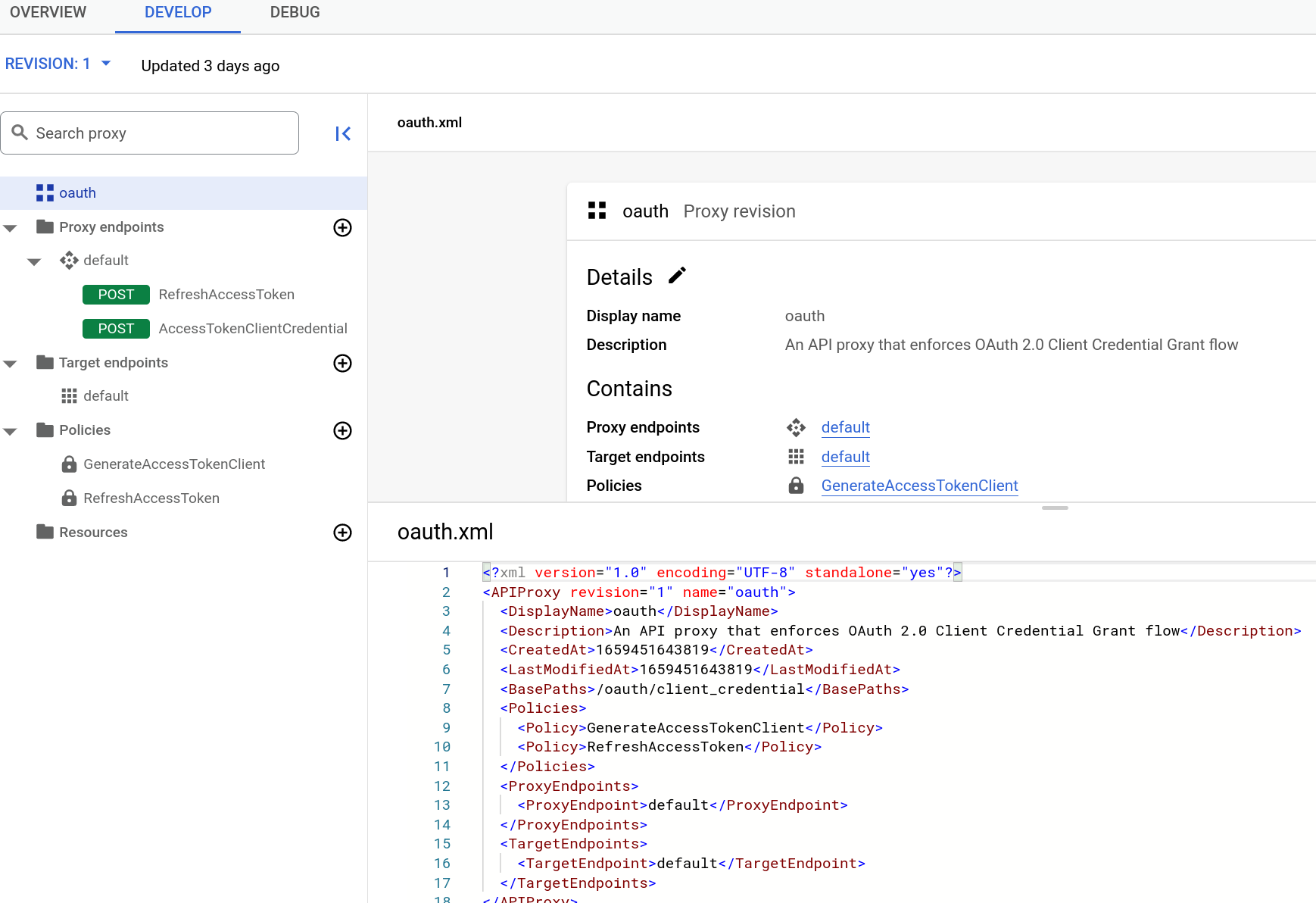
In the left-hand pane, you'll see two policies. You'll also see two POST flows in the Proxy Endpoints section.
- Click AccessTokenClientCredential under Proxy Endpoints.
The text editor displays the XML code for the
AccessTokenClientCredential conditional flow:
<Flow name="AccessTokenClientCredential"> <Description/> <Request> <Step> <Name>GenerateAccessTokenClient</Name> </Step> </Request> <Response/> <Condition>(proxy.pathsuffix MatchesPath "/accesstoken") and (request.verb = "POST")</Condition> </Flow>A flow is a processing step in an API proxy. In this case, the flow is triggered when a certain condition is met (it's called a "conditional flow"). The condition, defined in the
<Condition>element, says that if the API proxy call is made to the/accesstokenresource, and the request verb isPOST, then execute theGenerateAccessTokenClientpolicy, which generates the access token. - Now let's look at the policy the conditional flow will trigger. Click the
GenerateAccessTokenClient policy in the Request pane:
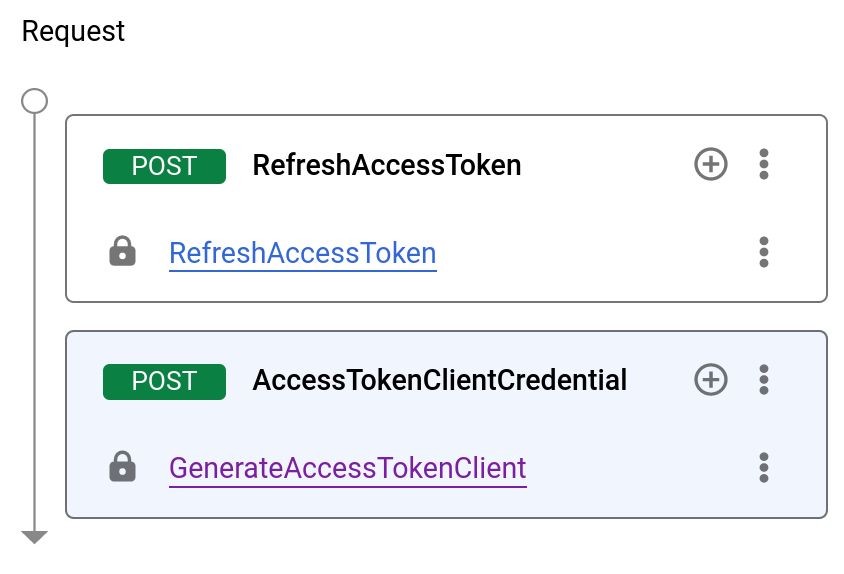
Classic Apigee
Next, you'll take a closer look at what the API proxy contains.
- In the API proxy editor, click the Develop tab. In the left Navigator pane, you'll see two policies. You'll also see two POST flows in the Proxy Endpoints section.
-
Click AccessTokenClientCredential under Proxy Endpoints.
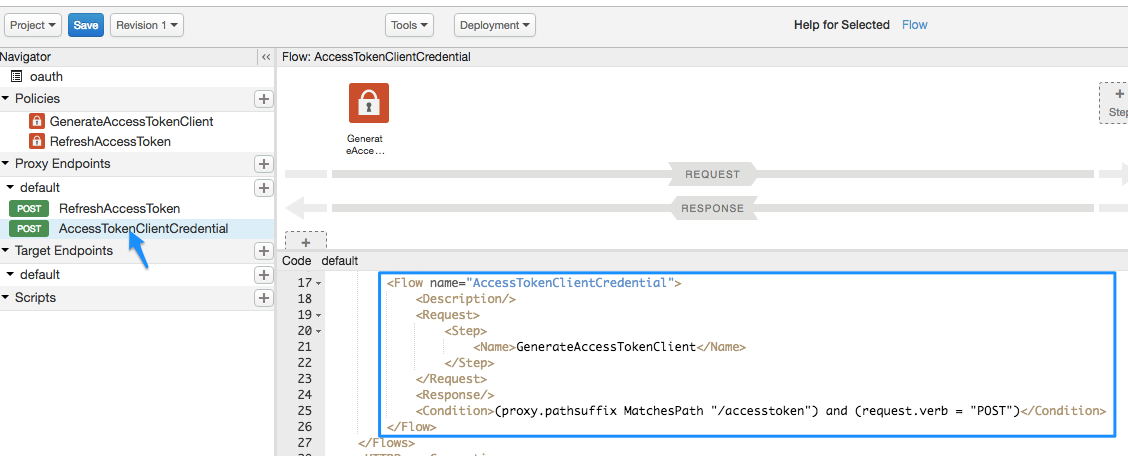
In the XML code view, you'll see a
FlowcalledAccessTokenClientCredential:<Flow name="AccessTokenClientCredential"> <Description/> <Request> <Step> <Name>GenerateAccessTokenClient</Name> </Step> </Request> <Response/> <Condition>(proxy.pathsuffix MatchesPath "/accesstoken") and (request.verb = "POST")</Condition> </Flow>A flow is a processing step in an API proxy. In this case, the flow is triggered when a certain condition is met. The condition, defined in the
<Condition>element, is that if the API proxy call is made to the/accesstokenresource, and the request verb isPOST, then execute theGenerateAccessTokenClientpolicy, which generates the access token. -
Now let's look at the policy the conditional flow will trigger. Click the GenerateAccessTokenClient policy icon in the flow diagram.
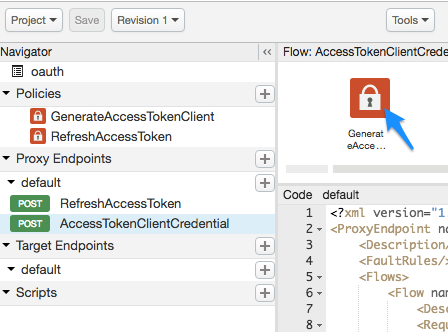
The following XML configuration is displayed:
<OAuthV2 name="GenerateAccessTokenClient"> <!-- This policy generates an OAuth 2.0 access token using the client_credentials grant type --> <Operation>GenerateAccessToken</Operation> <!-- This is in milliseconds, so expire in an hour --> <ExpiresIn>3600000</ExpiresIn> <SupportedGrantTypes> <!-- This part is very important: most real OAuth 2.0 apps will want to use other grant types. In this case it is important to NOT include the "client_credentials" type because it allows a client to get access to a token with no user authentication --> <GrantType>client_credentials</GrantType> </SupportedGrantTypes> <GrantType>request.queryparam.grant_type</GrantType> <GenerateResponse/> </OAuthV2>
The configuration includes the following:
- The
<Operation>, which can be one of several predefined values, defines what the policy is going to do. In this case, it's going to generate an access token. - The token will expire 1 hour (3600000 milliseconds) after being generated.
- In
<SupportedGrantTypes>, the OAuth 2.0<GrantType>expected to be used isclient_credentials(exchanging a consumer key and secret for an OAuth 2.0 token). - The second
<GrantType>element tells the policy where to look in the API call for the grant type parameter, as required by the OAuth 2.0 specification. (You'll see this in the API call later). The grant type could also be sent in the HTTP header (request.header.grant_type) or as a form parameter (request.formparam.grant_type).
You don't need to do anything else with the API proxy at the moment. In later steps, you'll use this API proxy to generate an OAuth 2.0 access token. But first, you need to do a few more things:
- Create the API proxy you actually want to secure with OAuth 2.0.
- Create a few more artifacts that will result in the consumer key and consumer secret you need to exchange for an access token.
Create a protected API proxy
Now you're going to create the API proxy you want to protect. This is the API call that returns something you want. In this case, the API proxy will call Apigee's mocktarget service to return your IP address. BUT, you'll get to see it only if you pass a valid OAuth 2.0 access token with your API call.
The API proxy you create here will include a policy that checks for an OAuth 2.0 token in the request.
Apigee in Cloud console
In the Google Cloud console, go to the Proxy development > API proxies page.
- In the API Proxies pane, click + Create.
- In the Create a proxy pane, under Proxy template, select Reverse proxy (most common).
- Configure the proxy with the following:
In this field do this Proxy Name Enter: helloworld_oauth2Base Path Change to:
/hellooauth2The Project Base Path is part of the URL used to make requests to the API proxy.
Description Enter: hello world protected by OAuth 2.0Target (Existing API) Enter:
https://mocktarget.apigee.net/ipThis defines the target URL that Apigee invokes on a request to the API proxy.
- Click Next.
- Deploy (optional):
- Deployment environments: Optional. Use the checkboxes to select one or more environments in which to deploy your proxy. If you prefer not to deploy the proxy at this point, leave the Deployment environments field empty. You can always deploy the proxy later.
- Service Account: Optional. Attach a service account to your deployment to enable your proxy to access Google Cloud services, as specified in the service account's role and permissions.
- Click Create.
- Click the Develop tab of the helloworld_oauth2 proxy.
- In the Policies menu, Click Add policy.
- In the Create policy pane, Select OAuth 2.0.
- Click Create.
Classic Apigee
- Go to the Apigee UI and sign in and select your Apigee organization.
- Select Develop > API Proxies in the left navigation bar.
- Click Create New.

- In the Build a Proxy wizard, select Reverse proxy (most common).
- Configure the proxy with the following:
In this field do this Proxy Name Enter: helloworld_oauth2Project Base Path Change to:
/hellooauth2The Project Base Path is part of the URL used to make requests to the API proxy.
Existing API Enter:
https://mocktarget.apigee.net/ipThis defines the target URL that Apigee invokes on a request to the API proxy.
Description Enter: hello world protected by OAuth 2.0 - Click Next.
- On the Common policies page:
In this field do this Security: Authorization Select: - OAuth 2.0
These options are very handy. They'll automatically add two policies to your API proxy and create an API product.
- Click Next.
- On the Summary page, under Optional Deployment, select an environment, and click Create and Deploy.
- Click Edit proxy to display the
Overview page for the API proxy.
The API proxy is automatically deployed for you. (It may take a few moments for the deployment to complete.)
View the policies
Let's take a closer look at what you've created.
Apigee Cloud console
- In the API proxy editor, click the Develop tab. You'll see that two
policies have been added to the request flow of the API proxy:
- Verify OAuth v2.0 Access Token – Checks the API call to make sure a valid OAuth 2.0 token is present.
- Remove Header Authorization – An Assign Message policy that removes the access token after it's checked, so that it doesn't get passed to the target service. (If the target service needed the OAuth 2.0 access token, you wouldn't use this policy).
-
Click the Verify OAuth v2.0 Access Token icon in the right-hand pane and look at the XML below it in the text editor.
Classic Apigee
- In the API proxy editor, click the Develop tab. You'll see that two
policies have been added to the request flow of the API proxy:
- Verify OAuth v2.0 Access Token – Checks the API call to make sure a valid OAuth 2.0 token is present.
- Remove Header Authorization – An Assign Message policy that removes the access token after it's checked, so that it doesn't get passed to the target service. (If the target service needed the OAuth 2.0 access token, you wouldn't use this policy).
-
Click the Verify OAuth v2.0 Access Token icon in the flow view and look at the XML below it in the code pane.
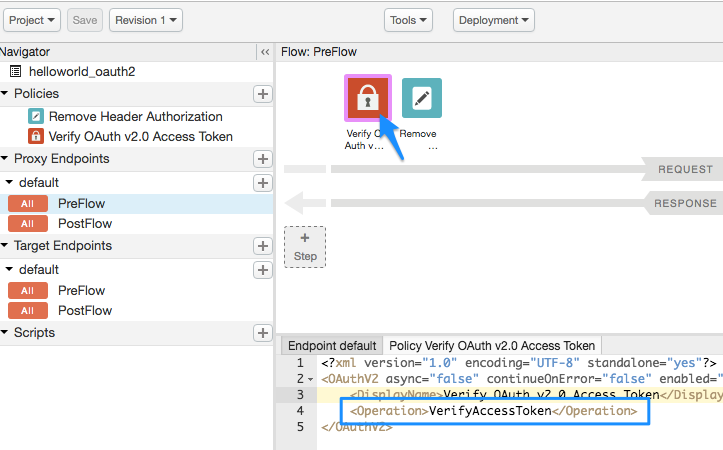
<OAuthV2 async="false" continueOnError="false" enabled="true" name="verify-oauth-v2-access-token">
<DisplayName>Verify OAuth v2.0 Access Token</DisplayName>
<Operation>VerifyAccessToken</Operation>
</OAuthV2>Notice that the <Operation> is VerifyAccessToken. The
Operation defines what the policy is supposed to do. In this case, it's going to check
for a valid OAuth 2.0 token in the request.
Add an API product
To obtain an OAuth 2.0 access token, you need to create three Apigee entities: an API product, a developer, and a developer app.
- Create the API product:
- Click + Create.
- Enter the Product details for your API product.
Field Description Name Internal name of the API product. Do not specify special characters in the name.
Note: You cannot edit the name once the API product is created.Display name Display name for the API product. The display name is used in the UI and you can edit it at any time. If not specified, the Name value will be used. This field is auto-filled using the Name value; you can edit or delete its contents. The display name can include special characters. Description Description of the API product. Environment Environments to which the API product will allow access. Select the environment to which you deployed the API proxy. Access Select Public. Automatically approve access requests Enable automatic approval of key requests for this API product from any app. Quota Ignore for this tutorial. Allowed OAuth 2.0 Scopes Ignore for this tutorial. - In the Operations section, click Add An Operation.
- In the API Proxy field, select the API proxy you just created.
- In the Path field, enter "/". Ignore the other fields.
- Click Save to save the Operation.
- Click Save to save the API product.
Apigee in Cloud console
In the Google Cloud console, go to the Distribution > API products page.
Classic Apigee
In the Apigee UI, go to Publish > API products.
Add a developer and app to your organization
Next, you're going to simulate the workflow of a developer signing up to use your APIs. Ideally, developers register themselves and their apps through your developer portal. In this step, though, you'll add a developer and an app as an administrator.
A developer will have one or more apps that call your APIs, and each app gets a unique consumer key and consumer secret. This key/secret-per-app also gives you, the API provider, more granular control over access to your APIs and more granular analytics reporting on API traffic, because Apigee knows which developer and app belong to which OAuth 2.0 token.
Create a developer
Let's create a developer named Nigel Tufnel.
Apigee in Cloud console
- Open the Developer editor.
-
In the Google Cloud console, go to the Distribution > Developers page.
- Click + Create.
- Enter the following in the Add Developer window:
In this field Enter First Name NigelLast Name TufnelEmail nigel@example.comUsername nigel - Click Add.
Classic Apigee
- Open the Developer editor.
-
In the Apigee UI, go to Publish > Developers.
- Click + Developer.
- Enter the following in the Create a Developer window:
In this field Enter First Name NigelLast Name TufnelEmail nigel@example.comUsername nigel - Click Create.
Register an app
Let's create an app for Nigel.
Apigee in Cloud console
-
In the Google Cloud console, go to Distribution > Apps page.
- Click + Create.
- Enter the following in the New App window:
In this field do this Name and Display Name Enter: nigel_appDeveloper Click Developer and select: Nigel Tufnel (nigel@example.com)Callback URL and Notes Leave blank - Click + Add Credentials.
- Click + Add Products.
- Select the API product you just created.
- Click Add.
- Click Create.
Classic Apigee
-
In the Apigee UI, go to Publish > Developers.
- Click + Developer.
- Click + App.
- Enter the following in the New App window:
In this field do this Name and Display Name Enter: nigel_appDeveloper Click Developer and select: Nigel Tufnel (nigel@example.com)Callback URL and Notes Leave blank - Under Products, click Add product.
- Add the API product you just created.
- Click Create.
Get the consumer key and consumer secret
Now you'll get the consumer key and consumer secret that will be exchanged for an OAuth 2.0 access token.
- Open the nigel_app page.
- Ensure that the nigel_app page is displayed. If not, go to the Distribution > Apps page.
- On the nigel_app page, click in the Key and Secret columns. Notice that the key/secret are associated with the API product that you created earlier.
- Ensure that the nigel_app page is displayed. If not, on the Apps page (Publish > Apps), click nigel_app.
-
On the nigel_app page, click Show in the Key and Secret columns. Notice that the key/secret are associated with the API product that you created earlier.
-
Select and copy the Key and Secret values. Paste them in a temporary text file. You'll use them in a later step, where you call the API proxy that will exchange these credentials for an OAuth 2.0 access token.
Apigee in Cloud console
Classic Apigee
Try calling the API to get your IP address (fail!)
Try calling the protected API proxy that you just created. Notice that you are not passing an OAuth 2.0 access token in the call.
where YOUR ENV_GROUP_HOSTNAME is the environment group hostname. See
Find the environment group hostname.
Because the API proxy has the Verify OAuth v2.0 Access Token policy checking for a valid OAuth 2.0 token in the request, the call should fail with the following message:
{"fault":{"faultstring":"Invalid access token","detail":{"errorcode":"oauth.v2.InvalidAccessToken"}}}In this case, failure is good! It means your API proxy is much more secure. Only trusted apps with a valid OAuth 2.0 access token can successfully call this API.
Get an OAuth 2.0 access token
Next, you will use the key and secret you copied and pasted into a text file and exchange them for an OAuth 2.0 access token. You're now going to make an API call to the API sample proxy you imported, oauth, which will generate an API access token.
Using that key and secret, make the following cURL call (note that the protocol is
https):
curl -X POST -H "Content-Type: application/x-www-form-urlencoded" \ "https://YOUR ENV_GROUP_HOSTNAME/oauth/client_credential/accesstoken?grant_type=client_credentials" \ -d "client_id=CLIENT_KEY&client_secret=CLIENT_SECRET"
Note that if you're using a client like Postman to make the call, the
client_id and client_secret go in the Body of the
request and must be x-www-form-urlencoded.
You should get a response like this:
{ "issued_at" : "1466025769306", "application_name" : "716bbe61-f14a-4d85-9b56-a62ff8e0d347", "scope" : "", "status" : "approved", "api_product_list" : "[helloworld_oauth2-Product]", "expires_in" : "3599", //--in seconds "developer.email" : "nigel@example.com", "token_type" : "BearerToken", "client_id" : "xNnREu1DNGfiwzQZ5HUN8IAUwZSW1GZW", "access_token" : "GTPY9VUHCqKVMRB0cHxnmAp0RXc0", "organization_name" : "myOrg", "refresh_token_expires_in" : "0", //--in seconds "refresh_count" : "0" }
You got your OAuth 2.0 access token! Copy the access_token value (without the quote marks) and
paste it into your text file. You'll use it in a moment.
What just happened?
Remember previously when you looked at that "conditional flow" in the
oauth proxy, the one that said if the resource URI is
/accesstoken and the request verb is POST, to execute the
GenerateAccessTokenClient OAuth 2.0 policy that generates an access token? Your cURL
command met those conditions, so the OAuth 2.0 policy was executed. It verified your consumer key
and consumer secret and exchanged them for an OAuth 2.0 token that expires in 1 hour.
Call the API with an access token (success!)
Now that you have an access token, you can use it to call the API proxy. Make the following cURL call. Substitute your Apigee organization name and the access token.
curl https://YOUR ENV_GROUP_HOSTNAME/hellooauth2 -H "Authorization: Bearer TOKEN"
You should now get a successful call to the API proxy that returns your IP address. For example:
{"ip":"::ffff:192.168.14.136"}You can repeat that API call for close to an hour, after which time the access token will expire. To make the call after an hour, you'll need to generate a new access token using the previous steps.
Congratulations! You've created an API proxy and protected it by requiring that a valid OAuth 2.0 access token be included in the call.
Related topics
- OAuth 2.0 home
- OAuthV2 policy
- Download API proxies (which shows how to bundle an API proxy into a ZIP file like the one you downloaded)
